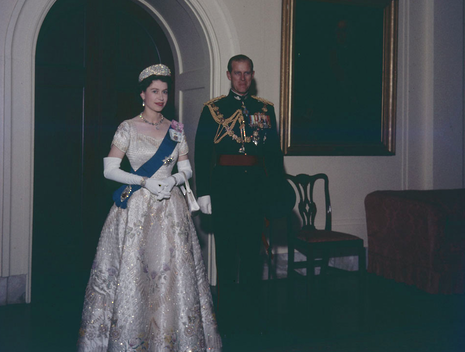Framing the Queen
Anna Kathis explores new trends in depicting the Queen

Queen Elizabeth II recently celebrated her 90th birthday with no intention of abdicating and retiring. However, the longest reigning British monarch needs the public's sympathy on her side. Costing the taxpayers around £40m per year (£1.26 pounds per taxpayer) according to the Independent, it is crucial for the Queen and the royal family – the third wealthiest in Europe with £340m at their disposal – to sustain public support and to establish a likeable public image. While little is known about the Queen's personal feelings or political opinions, the royal family and the Queen in particular have made their ways into our daily lives in surprising and original ways that are more than just entertainment fit for the Daily Mail.
Over her reign, the Queen has become ever more open to humorous and realistic ways of being portrayed. Long gone are the days of images of a classical fairytale queen, as the Queen was depicted at the time around her coronation. Already in the 1960s, the documentary Royal Family offered 23 million viewers an unprecedented peek into the lives of the royals, with the Queen making small talk with US President Richard Nixon and the Duke of Edinburgh frying sausages at Balmoral.
Another unexpected public appearance was made by the Queen as part of the opening ceremony of the London 2012 Summer Olympics, as she made a cameo appearance alongside James Bond in a short film. Not only has she received an honorary BAFTA for her patronage of the film industry, but she also remains the most memorable Bond girl ever to have starred alongside Daniel Craig.
In 2001, a portrait of the Queen by Lucian Freud provoked diverse opinions. Freud's characteristically naturalistic portrait shows the Queen wearing a severe expression with rendered features. The critiques ranged from ‘Freud should be locked in the Tower for this’ and ‘It makes her look like one of the royal corgis who has suffered a stroke’ to the Independent hailing the painting as the most honest representation of the monarch to date. Adrian Searle, the Guardian's art critique, even went so far as to call it the best royal portrait in 150 years, suggesting that Freud had got beneath the powder. The small portrait has since not only made it into the Royal Collection, but is also the subject of the colour print The Queen sits for Lucian Freud by David Dawson, indicating just how much importance and relevance is attached to every single action the Queen takes.
Portrayals of the Queen have since broken out of the traditional realm of official portraits and photographs and spread into trashier pop culture: Bobble Heads started creating prototypes of Her Majesty The Queen Bobble Heads in 2015.
Another new dimension to the depiction of the Queen and the royal family has emerged with the growth of social media. Cleverly restaging themselves, the royals used Instagram to thank Obama for the new rocking-horse George received, achieving over 100,000 likes, and posting pictures of the Queen feeding horses to promote TV programmes celebrating her birthday. By using exactly the same channels we use to communicate with our friends and relatives, the royal family does not only enter our everyday lives by allowing us to enter theirs, but also reduces the barrier that has separated their ancestors from the populace.
The royal family Instagram account, competently applying filters and posting videos, has evoked responses from 'I hope I look as great as she does when I am 90' to rather more blunt 'Die Bitch' comments. The royal family has also conquered Twitter, with 2,21 million followers and over 22,600 tweets ranging from “The Countess of Wessex practices her hockey” to “The Queen does not need her own passport because one is issued for Her Majesty”. Currently, the royal family is searching for a social media consultant to boost the family's presence on Facebook and Twitter and to ensure a worldwide audience, with a regal annual salary of £50k.
However, a 2015 poll by YouGov revealed only 32 per cent of the British public think that the Queen should open up more and go less private, compared to 50 per cent who want things to stay as they are.
To mark the Queen’s 90th birthday, BBC released the film Elizabeth at 90. The film includes previously unseen footage shot by the Queen herself, showing the royal family behind the curtains, enjoying a water slide aboard the royal yacht Britannia and playing pranks on each other. Among the scenes is Prince William paying tribute to the Queen and Prince Philip’s marriage at his own wedding: “I would love to know their secrets. They are the most lovely couple and I hope Cathereine and I have the same sort of future ahead of us, as happily married as they are, for 68 years." Good luck with that. And with making the next 68 years look as attractive as possible to the public.
 Comment / Plastic pubs: the problem with Cambridge alehouses 5 January 2026
Comment / Plastic pubs: the problem with Cambridge alehouses 5 January 2026 News / Cambridge academics stand out in King’s 2026 Honours List2 January 2026
News / Cambridge academics stand out in King’s 2026 Honours List2 January 2026 News / Cambridge businesses concerned infrastructure delays will hurt growth5 January 2026
News / Cambridge businesses concerned infrastructure delays will hurt growth5 January 2026 News / AstraZeneca sues for £32 million over faulty construction at Cambridge Campus31 December 2025
News / AstraZeneca sues for £32 million over faulty construction at Cambridge Campus31 December 2025 Interviews / You don’t need to peak at Cambridge, says Robin Harding31 December 2025
Interviews / You don’t need to peak at Cambridge, says Robin Harding31 December 2025









